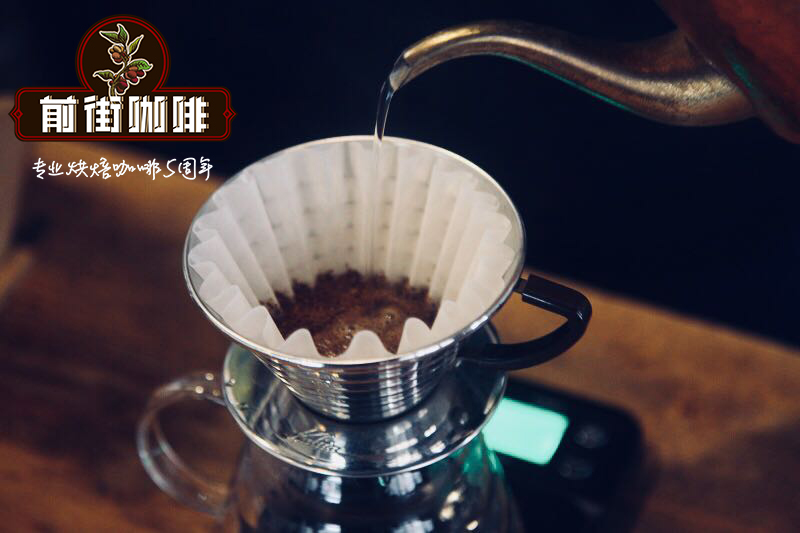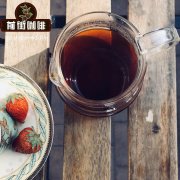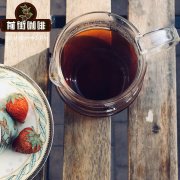How to make a cup of coffee and how to make coffee by hand?

Professional coffee knowledge exchange more coffee bean information please follow the coffee workshop (Wechat official account cafe_style)
Gently hold the filter cup and place it on the pot. The filter paper is folded and unfolded according to the stitches and spread in the filter cup. Take a ladle of beans from the bean jar and pour them into the bean grinder. Turning in one or two circles, the slight aroma spreads when the sound of Kala and rustling weakens, and pervades the space when the lid is opened. The heavy water first reached the boiling point, the smoke was ethereal from the mouth of the hot pot, and there was a dull murmur. Transfer a little water to the hand flushing pot and sprinkle it on the filter cup to warm the body and remove the dust from the filter paper. Pour the ground coffee powder into the filter cup and pat the whole powder.
Hold the kettle by hand, pour your ideas into the water column, or gently, or unrestrained, draw a circle with one heart. At the right time, when the water is cut off, the kettle is closed, and the man is still, leaving the current to trickle. Pour the remaining water from the hand flushing pot into the cup, warm the cup and warm the hand of the cup. Fill the cup with amber coffee.
If you have no mind, give it to yourself or your friends, with a pure time.
Before cooking, match a set of utensils of your own style
Filter cup, pot, filter paper. Bean cans, bean spoons, bean grinders. Hot kettle, hand flushing kettle. A cup.
The popularity of hand-brewed coffee has greatly lowered the threshold for us to make our own coffee at home. Compared with making espresso such as latte, it takes tens of thousands of yuan to make coffee machine, and hand coffee can be made with a lower budget. It is easy to find instruments that are easy to start with, and there are many choices, so it is very suitable to match your personal style according to your preferences or mood.
Special attention should be paid to the collocation of filter cup and filter paper when purchasing. Many filter cups show different views on coffee extraction in design, extending the specific requirements for the shape of filter paper, for example, common filter paper can be tapered, fan-shaped, or even wavy. Friends who are full of experimental spirit or like scientific research can buy electronic scales, thermometers and timers. These three can more accurately control the amount of coffee beans we use, the temperature and amount of water, and the extraction time. In recent years, many manufacturers have combined the hand punch with the heating base to develop a temperature-controlled heating kettle, which can also be used as a hot kettle.
Bean cans, the ideal is an opaque sealed can. The choice of bean cans involves the preservation of coffee beans, and the best preservation is in an environment that avoids rapid oxidation, low temperature drying and light. It should be noted that the remaining space after pouring coffee beans into the bean jar does not need to be too large, one is to reduce the air in the jar, and the other is to reduce the space for the aroma volatilization of coffee beans. If you want to store in the refrigerator, you should pay attention to the tightness to avoid absorbing the odor in the refrigerator, and the second is the problem of water dissipation during rapid thawing and rewarming.
It is sincerely suggested that if beginners want to quickly improve the flavor of their coffee brewing, the first equipment that needs to be purchased or upgraded is a "bean grinder", a quick and convenient electric style, or a hand grind bean that pursues a slow feel, whichever way, fresh cooking can definitely preserve more of the fascinating details of the coffee.
Finally, please prepare a cup of your own style to hold your coffee, whether drinking or entertaining guests.
Drink and read what the coffee says
When you construct a personal style scene with utensils, you can clearly see a kind of ceremony and human feelings like the Japanese tea ceremony. However, the western scientific materialism and coffee culture spread eastward by the hot third wave of coffee in recent years, with special emphasis on smell and taste, put forward a new perspective based on the senses. Let us examine that the past tea ceremony focused on the ceremony, spirit, atmosphere and artistic conception constructed from the utensils, but there seems to be a lack of a very important piece: the language of the thing itself.
And "flavor" is the language that the "thing" of coffee can tell us.
In this international sensory evaluation, the items for testing coffee are as follows (take the American Fine Coffee Association as an example): the smell of dry and wet aroma, the flavor in the mouth when sipping, the residual rhyme in the throat, the acidity of the taste, the tactile sensation on the tongue (a comprehensive score of mellow and texture), the balance, sweetness, consistency, cleanliness of the overall performance, and whether there is a defective flavor.
In this way, we can simply convey the drinker's subjective preferences, and then objectively express the performance of each coffee in all aspects, and even use specific odor nouns to describe the aroma felt in the sense of smell. for example, jasmine, hazelnut, citrus, dark chocolate and so on, accurately describe the most unique appearance of each coffee. Knowledge can only make us understand coffee, and flavor is the only language in which we can feel coffee itself. Only by imagining the delicious flavor can we move forward to that imagination and brew a cup of coffee that we like.
Before you "brew" a cup of coffee, you must know how to drink it.
The process of making coffee by hand
Although the techniques of hand-brewing coffee are often divided into different schools, except for the extreme school of the sword, it generally does not take off the three stages of "preparation, steaming and brewing".
Preparation: soak the filter paper and preheat the coffee pot to remove the odor absorbed by the filter paper in the air. Pour the ground coffee powder into the filter cup, tap the cup edge and flatten the coffee powder layer. More importantly, warm up, take a deep breath, calm your mind, and get ready to put yourself into cooking.
Steaming: it is also called pre-soaking. Gently pour in a small amount of water, wet all the coffee powder and wait for about 15 to 30 seconds. Soaked coffee powder will often slowly expand and stretch like mushrooms, which is a very healing picture.
Brewing: keep the water column in a steady state and walk in a circle from the center of the circle to the circle and to the heart. According to the rhythm and rhythm of your heart, imagine that the column of water is an extension of your fingers, poking all the coffee powder. Collect water to tie the knot when appropriate.
If you are in a suitable environment, you can often feel the aroma of coffee in the process of brewing, as if you were in the fragrance. The people who enjoy it most are often the ones who cook it.
The way to make coffee by hand
In hand-brewed coffee, a person's style will eventually be reduced to the flavor of a cup of coffee. Assuming that flavor is the invisible words that a cup of coffee is saying to the drinker, there is no other way for the brewer to make progress, that is, three steps: to understand what each cup of coffee is saying, to understand what brewing will make the coffee speak, and to make the coffee speak through brewing your own thoughts.
What are the coffee beans talking about?
The brewing of a cup of coffee begins with choosing beans. The flavor and texture of the raw material itself has determined the vocabulary you can tell. There is no shortcut to choosing beans or understanding what each coffee bean is talking about. the only way is to increase the personal experience of drinking coffee. For example, try coffee from different producing areas in a cafe, or broaden your horizons by experiencing different interpretations of the same bean in multiple cafes.
But we can still try to draw a little longitude and latitude in our mind through reading, through the characteristics of the place of origin and the degree of baking, so as to avoid getting lost in the vast sea of coffee, but remember to keep an open mind and face every bean in front of us.
Place of Origin
Africa: African beans are represented by Ethiopia. Washed Yegashev is often floral and citrus-lemon mellow, light and elegant, while sun-treated ones are full-bodied with rich berries or rich fruit notes. Another representative country is Kenya, which not only has the flavor of black plum, but also has a unique taste among African beans.
Central and South America: central and South America is usually famous for its mild, balanced flavor. Often with the flavor of nuts and caramel as the main performance. It used to be famous for Brazil and Colombia. In recent years, Geisha coffee from Panama has attracted a lot of attention because of its strong nectar and citrus flavor.
Asia: the representative of Asia is Sumatra of Indonesia, which we often hear of as Mantenin. Low acidity, excellent mellow and thick feeling, coupled with the unique flavor of sunwood and herbs, can be called the oriental flavor of coffee.
Baking degree
Shallow roasting: coffee is easy to show its original flavor in the performance of shallow roasting, such as flower, fruit and herbal aroma. But it is also because coffee beans are baked from the seeds of the fruit, so it is easy to have the obvious sour feeling of fruits under shallow roasting.
Medium roasting: when coffee is roasted in the middle, it is easier to show the aroma of caramel such as nuts and honey, or honey, with obvious sweetness and weaker acidity. If you go a little deeper, you will have a chocolate flavor.
Deep roasting: deep-roasted coffee is probably the flavor we take for granted. Deep-roasted coffee is usually not sour and bitterness increases gradually. It is accompanied by the smell of smoke, carbon roasting, or wood, spices and so on.
Yegashev, who is washed with water, is often ordered at every store. On the one hand, the washed Yejashev itself is a classic basic style, and the other is that you can know the location of the shop through the roasting of the coffee in a store. At the same time, Yegashev is one of the most representative producing areas in the era of boutique coffee. He also recommends that beginners start with the classics of each era, such as the present-day Yegashev, or the old blue mountains of Jamaica, from which we can peek at the emphasized aspects of each era and extend them as a benchmark.
How to make coffee talk?
Coffee is very demanding for brewing conditions. without a certain degree of understanding to help brew coffee, it will either become a thin, tasteless mute or a broken gong voice full of bitterness. In the scientific research at the present stage, it is pointed out that the six major factors that will affect the flavor in the cooking process are as follows: the ratio of water to powder, water temperature, powder thickness, extraction time, filter material, water flow disturbance.
It is believed that the objective parameters constructed by scientific and statistical methods in the West today are more like the imagination of top students and standard values, but it is easy to cause problems that are too similar. How to make a cup of "delicious" coffee? It will not only be limited by objective environment and resources, but also affected by subjective preferences and culture. These variables, and even the six factors mentioned above, are actually a system that drives the whole body. He cited the holistic thinking of traditional Chinese medicine as an example. if we only take stop-gap measures when we encounter problems, we are often unable to really solve the problems. For example, when we try to reduce the acidity in cooking, it may also weaken its flavor performance at the same time.
Beginners can start from themselves, set a more natural and stable cooking method for themselves, take this as a benchmark, and then, supplemented by simple scientific principles, change one cause at a time to correct the flavor within their own control. We can adjust our brewing according to the coffee flavor correction chart below:
First of all, you can find a similar description of your coffee flavor in the circle, and then you can see the suggestion of brewing correction in the outermost circle to adjust your next cup. For example, this cup of coffee has a "sense of water", and the suggestion corresponding to the outermost circle is to "increase the extraction rate." then in the next cup, you can grind the coffee powder finer and brew it for a longer time. You can move towards the "flavor balance" of the center.
How to say what you want to say through coffee?
In the end, it is people's preferences and thoughts that determine what a cup of coffee says. A cup of coffee with personal style and soul, "a cup of coffee with thought." "to achieve this goal, it can be divided into two stages: the ability to imagine the flavor before cooking, and the ability to imagine in practice. Imagination, which comes from the experience of drinking and delicious flavor, tries to establish a method or discussion in your mind, and to practice the discussion in the cooking process through a trained, controllable body.
Starting from the flavor of the cup of coffee in front of him, it extends to the use of utensils and even the layout of space to construct a personal style. After all, not just the flavor, but everything around us does affect us. The key point is that the cup of "things" tells the harmony with the atmosphere, even the spirit and artistic conception.
Everyone has his own style, and each coffee has its own flavor. The different cups of coffee made by different people are even more varied. Haruki Murakami dreamed that if our language was whiskey: "all I have to do is hold out my glass, and you just have to take it and quietly put it down your throat, as long as it should be done." "if we don't have to really talk, we can hold my words in a coffee cup, and you take it. In some quiet happy moment, you can understand me. That would be great。
For more professional coffee exchanges, please scan the code and follow Wechat: FrontStreetCoffee
Important Notice :
前街咖啡 FrontStreet Coffee has moved to new addredd:
FrontStreet Coffee Address: 315,Donghua East Road,GuangZhou
Tel:020 38364473
- Prev

How to choose coffee beans? Types of coffee beans recommended by coffee beans brands
Professional coffee knowledge exchange more coffee bean information Please follow the coffee workshop (Wechat official account cafe_style) long before the quality of coffee, experts have been very persistent in the selection of coffee beans, for no other reason, to taste a good cup of coffee, or to find a cup of coffee that meets their requirements, the only way is to start with coffee beans! The smell of coffee is not simple.
- Next

What is hand coffee? what are the utensils for making coffee by hand? Starbucks hand flush
Professional coffee knowledge exchange more coffee bean information Please follow the coffee workshop (Wechat official account cafe_style) hand-made coffee can be said to be a process of art, philosophy, practice and self-discovery. Friends who are serious about coffee and pay attention to coffee, I believe they all have this experience: the taste of coffee brewed every day will be different, which link is different? So every time it's different.
Related
- Beginners will see the "Coffee pull flower" guide!
- What is the difference between ice blog purified milk and ordinary milk coffee?
- Why is the Philippines the largest producer of crops in Liberia?
- For coffee extraction, should the fine powder be retained?
- How does extracted espresso fill pressed powder? How much strength does it take to press the powder?
- How to make jasmine cold extract coffee? Is the jasmine + latte good?
- Will this little toy really make the coffee taste better? How does Lily Drip affect coffee extraction?
- Will the action of slapping the filter cup also affect coffee extraction?
- What's the difference between powder-to-water ratio and powder-to-liquid ratio?
- What is the Ethiopian local species? What does it have to do with Heirloom native species?

